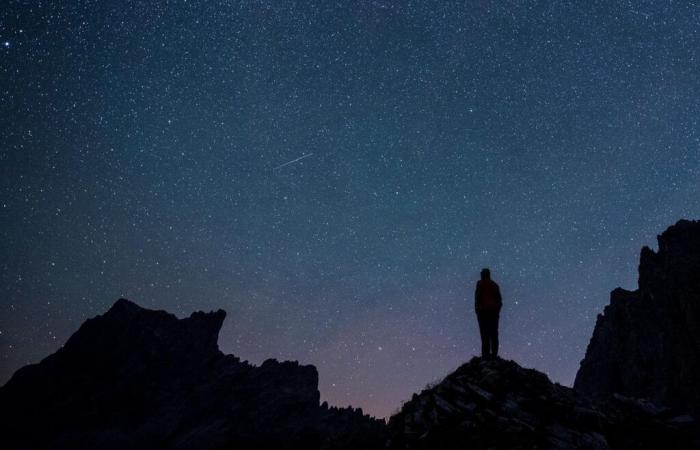Shower of shooting stars –
The Leonids will light up the Swiss sky this Sunday evening
Like every year in November, amateur and professional astronomers will be able to admire a shower of shooting stars. The peak of the phenomenon is expected during the night from Sunday to Monday.
Published today at 10:31 a.m.
The Leonids are quite fast meteors, with a speed of around 70 kilometers per second.
KEYSTONE
Subscribe now and enjoy the audio playback feature.
BotTalk
- The Leonid peak occurs between November 17 and 18.
- The almost full moon lighting makes it difficult to observe these meteors.
- The Leonids come from the debris of comet 55P/Tempel-Tuttle.
If you have a wish to make, now is the time! Because it is between November 17 and 18 that the peak activity of the Leonid meteor shower will take place, declared Marc Eichenberger, president of the Swiss Astronomical Society, to the Keystone press agency. ATS.
The Leonids are one of the most notable meteor showers of the year. These meteors are known to be fast, bright and sometimes colorful. At their peak, the Leonids produce up to 20 meteors per hour. It is also one of the rare meteor showers to experience regular eruptions (every 33 years), notes the specialist site Starwalk.
However, as the Moon was full two days before the maximum and therefore still lights the sky all night, it should be difficult to spot the meteors, which are rather weak in intensity.
In principle, it is recommended to watch for celestial bodies above the fog limit or wherever the sky is clear and dark, notes Marc Eichenberger. However, in the days to come, the sky will only be clear in Valais and south of the Alps, MeteoSwiss reports. In the plains and on the Plateau, fog should dominate this weekend.
The Earth passes through the debris of a comet
The Leonid shooting stars are so called because they come from the constellation Leo (Leo). But they are observable almost everywhere in the sky when viewed from Earth. The ideal is to find an observation post in a poorly lit area.
These shooting stars are actually debris from comet 55P/Tempel-Tuttel, through which the Earth passes once a year. This comet was discovered in 1865 by the German astronomer Ernst Tempel, and it was also spotted in 1866 by the American Horace Tuttel, which explains its double name.
The Leonids are quite fast meteors, with a speed of around 70 kilometers per second, or 252,000 kilometers per hour. “They zoom near the horizon and are known for their long, colorful tails,” notes NASA.
The Leonids are also known to cause explosions of light and color “that can persist longer than an average meteorite trail, because these fireballs come from larger particles of cometary material,” notes the US space agency. .
It happens, but it is rarer, that these meteorites offer a particular spectacle, called the Leonid storm. These episodes occur every 33 years. According to NASA, the last of these storms took place in 2002. In such a context, we can observe hundreds, even thousands of meteors per hour, depending on where we are.
The year 1966 was marked by yet another very spectacular Leonid storm. At that point, “viewers were able to see thousands of meteors fall through the Earth’s atmosphere over a period of fifteen minutes. We saw so many meteors that they seemed to fall like rain,” specifies the space agency, before warning that the next spectacle of this kind will not take place before 2030.
With no storm forecast this year, fans will console themselves with a more classic episode of Leonid rain in the coming days.
“Latest news”
Want to stay on top of the news? “24 Heures” offers you two appointments per day, directly in your email box. So you don’t miss anything that’s happening in your Canton, in Switzerland or around the world.
Other newsletters
Log in
LMD with agencies
Did you find an error? Please report it to us.
0 comments






